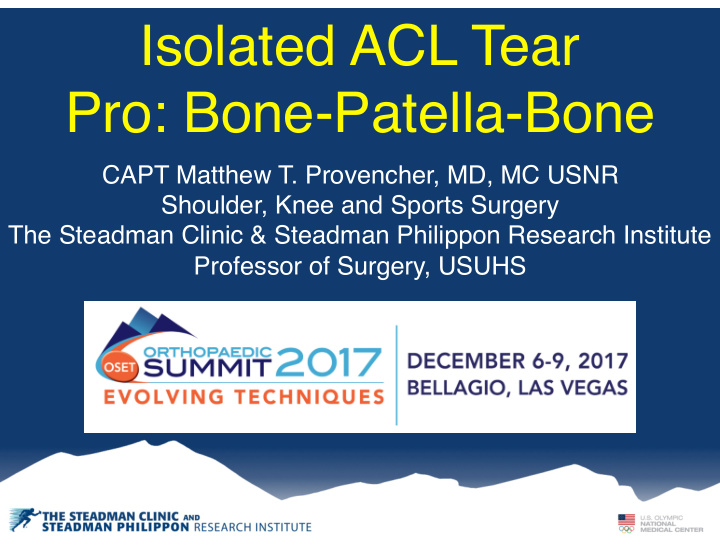



Isolated ACL Tear Pro: Bone-Patella-Bone CAPT Matthew T. Provencher, MD, MC USNR Shoulder, Knee and Sports Surgery The Steadman Clinic & Steadman Philippon Research Institute Professor of Surgery, USUHS
Disclosures • Royalties - Arthrex • Stock - None • Consultant - Arthrex; JRF • Research Support - AOSSM Grant (2005); AANA Research Grant (2008; 2006); OREF Grants (2002; 2004); BUMED (2009; 2012; 2014) • Editorial Boards - Elsevier (Arthroscopy - Asst. Editor in Chief; JSES), JBJS, JAAOS, SLACK (Orthopaedics, JKS), Sage (AJSM) • Board Memberships - AOSSM (Board of Directors, Research); SOMOS (Past Pres.); AAOS (Program; Annual Meeting); BOS/BOC (Research); ISAKOS (UE); AANA (Program/Education); ASES (Program; Membership; Technology)
Debate case • A 33-Year-Old Yoga Lover • Former Ballet Professional • Isolated ACL Tear
1996 • 127 patients - randomized study of three arthroscopically assisted reconstruction techniques • 125 f/u for mean 42 months • semitendinosus-gracilis vs. two incision BTB vs. one incision BTB • KT-2000 and International Knee Documentation Committee • Two incision BTB - • returned to a greater level of athletic activity (p < 0.02) • higher percentage of the pts in this group had a difference of three millimeters or less on testing with the KT-2000 (p < 0.08)
2001 • BTB vs. Semi-T and gracilis w/ extra-articular procedure vs. Semi-T and gracilis alone • 102 patients w/ mean 35 month f/u • Assessed via International Knee Documentation Committee knee evaluation and KT-1000 • Found increased laxity on instrumented testing in the non- BTB groups • Lesser Outcomes with Increased Laxity!
2002 • 56 patients - 28 randomized to BTB, 28 to semitendinosus-gracilis • F/U for mean 39 months • Evaluated in terms of clinical test findings, patient satisfaction, activity level, functional status. and isokinetic muscle strength • Hamstring graft - had an average of 4.4 mm of increased anterior knee laxity, BTB - 1.1 mm of increased knee laxity • 14% of hamstring pts had a mild pivot shift, 27% had a moderate pivot shift • Only 14% of BTB had a mild pivot shift, and none had a moderate pivot shift • Hamstring graft had been used had significantly lower peak knee-flexion strength than BTB (p = 0.039)
2009 • Patients with patellar tendon grafts had greater Tegner activity scores (P = .04) • Single Assessment Numeric Evaluation scores: • 88.5 - hamstring • 90.1 - BTB (P = .53) • Lysholm scores: • 90.3 - hamstring • 90.4 - BTB (P = .97) • Postoperative graft rupture correlated with more horizontal tibial tunnel orientation
In female pts specifically? 2004 • 101 pts f/u for 24 months after ACLR w/ multiple-looped semitendinosus • 51 men and 50 women • Postoperative differences in joint stability tested by KT2000 • Significant difference between post-op men, − 2.3 to 4.1, and women, − 0.4 to 6.8 (P<0.01). • >3 mm difference in 4% of men and 12% of women • Increased failure rate in women compared with men with the hamstring graft
In female pts specifically? 2004 • Prospectively followed 80 comparable athletes, 46 males, 32 females, after ACLR using either patellar tendon or hamstring graft for mean 36 months. • BTB group - 26 males and 14 females • Hamstring group - 22 males and 18 females • Assessed by clinical evaluation, computerized knee laxity analysis, isokinetic and functional strength tests, and standard knee scores • Females in the hamstring group had significantly greater laxity, and isokinetic tests at 1 year revealed a significantly higher deficit of peak torque at 60°/s in flexion and extension.
2017 Systematic review of sixteen meta-analyses • The number of patients analyzed ranged from 361 to 3402 with a mean 1396 • patients meeting eligibility criteria per study. Most studies found BPTB autografts to provide superior stability… • but more postoperative complications, such as anterior knee pain and kneeling - pain. 5 studies found BPTB autograft had a significantly increased chance of - attaining a statically stable knee 6 studies found that patients with a BPTB autograft had a significantly lower - rate of positive pivot-shift test findings.
What Do We Do in NFL?
2014 Preferred graft choice for: ALCR 20 y.o. starting NCAA Division 1 ACLR for 25 y.o. recreational or NFL running back athlete
Op Plan • ACL revision reconstruction of BTB allograft • FCL reconstruction with semitendinosus allograft
Demonstration of technique in another case
ACL Harvest
Retrograde Drilling of Femoral Tunnel
Passing graft
What Would You DO? • Evidence shows BTB Most Favorable in this Case!
Thank You!
Recommend
More recommend